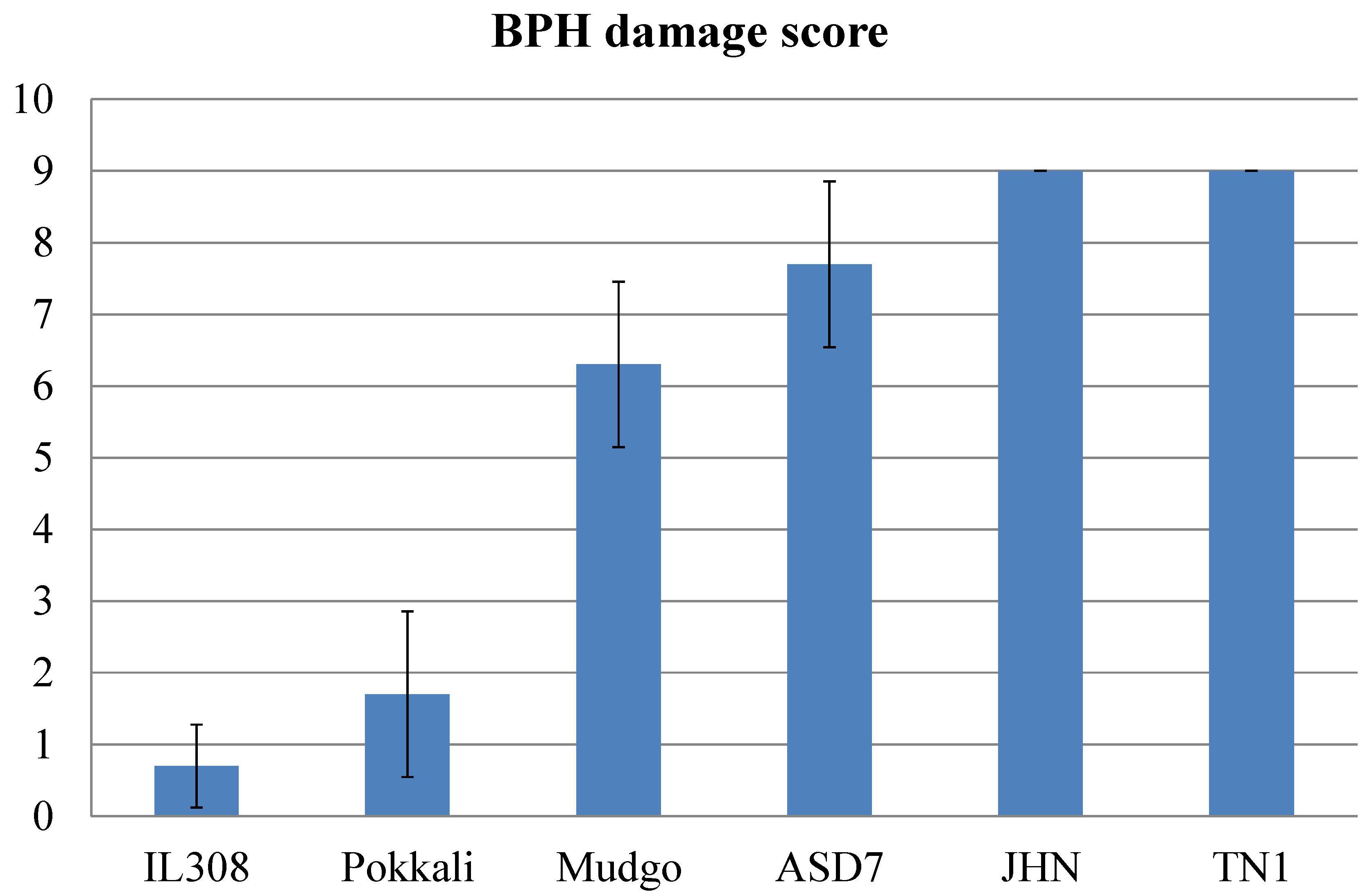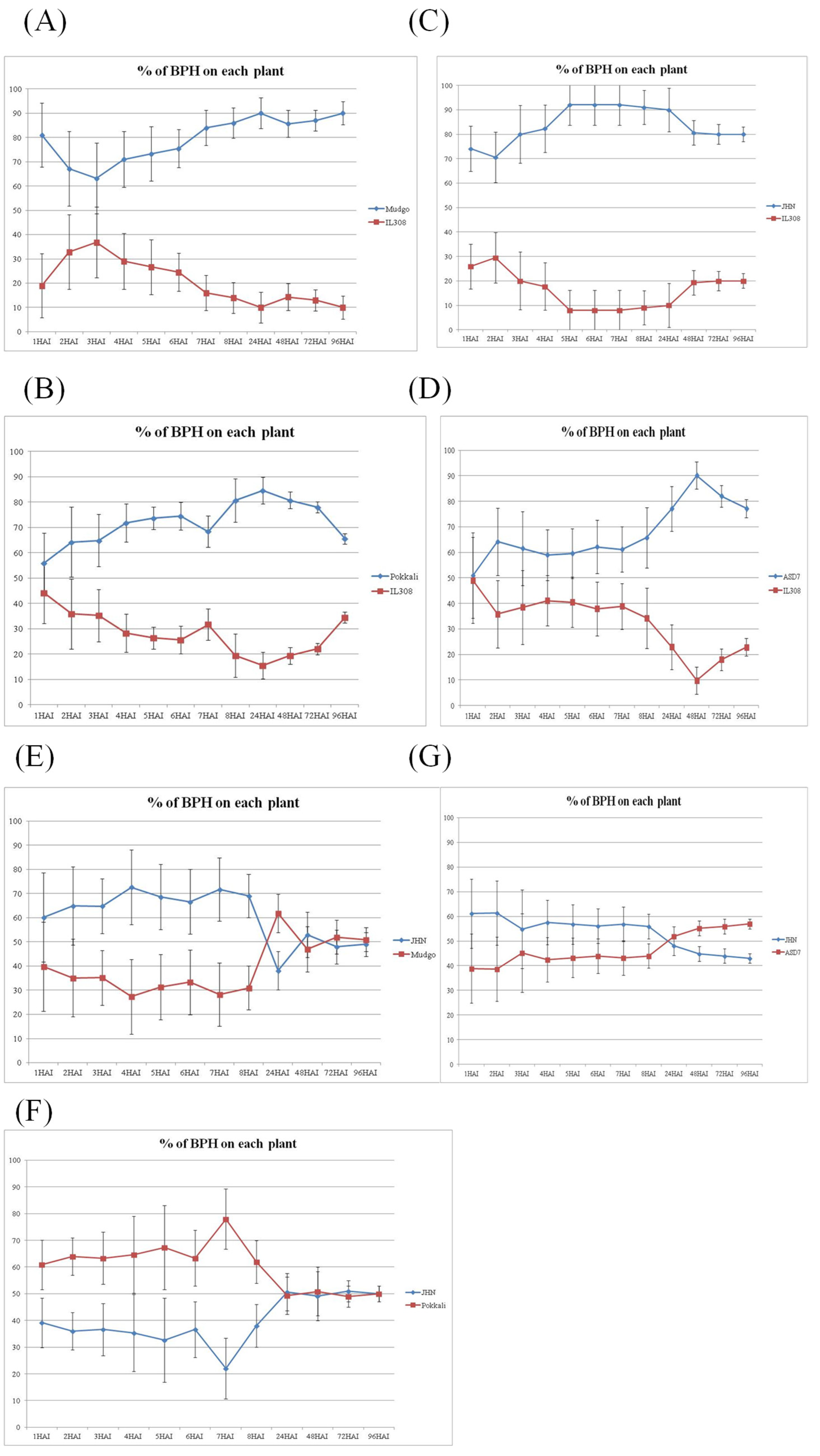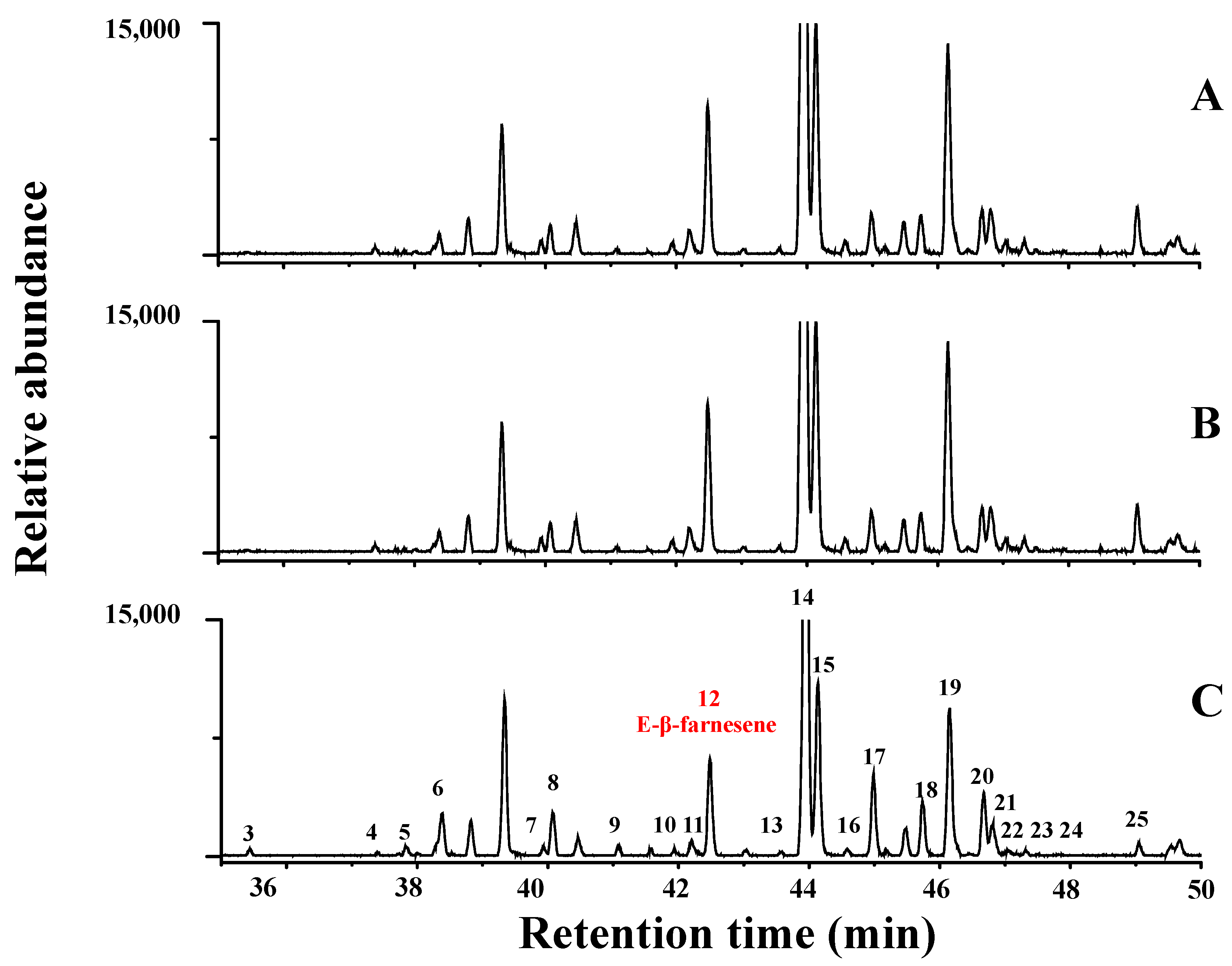Rice Sesquiterpene Plays Important Roles in Antixenosis against Brown Planthopper in Rice
Abstract
1. Introduction
2. Results and Discussion
2.1. Expression of OsSTPS2 Is Associated with SNPs at Transcription Factor (TF) Binding Sites
2.2. The Seven Amino Acid Deletion in OsSTPS2 Is a Natural Variation
2.3. Antixenosis Mechanism Is Not Functional in Rice Varieties Harboring a Seven Amino Acid Deletion in the OsSTPS2 Gene
2.4. OsSTPS2 Is Responsible for the Production of E-β-Farnesene in RH and IL Infested by BPH
3. Materials and Methods
3.1. Plant Materials and BPH Treatment
3.2. Genomic and Expression Analysis of OsSTPS2
3.3. BPH Resistance Evaluation
3.4. Antixenosis BPH Resistance Mechanism
3.5. Plant Volatile Collection and Identification
Supplementary Materials
Author Contributions
Funding
Institutional Review Board Statement
Informed Consent Statement
Data Availability Statement
Acknowledgments
Conflicts of Interest
References
- Xu, T.; Zhou, Q.; Xia, Q.; Zhang, W.; Zhang, G.; Gu, D. Effects of herbivore-induced rice volatiles on the host selection be-havior of brown planthopper, Nilaparvata lugens. Chin. Sci. Bull. 2002, 47, 1355–1360. [Google Scholar] [CrossRef]
- Saxena, R.C.; Okech, S.H. Role of plant volatiles in resistance of selected rice varieties to brown planthopper, Nilaparvata lugens (Stål) (Homoptera: Delphacidae). J. Chem. Ecol. 1985, 11, 1601–1616. [Google Scholar] [CrossRef] [PubMed]
- Degenhardt, J.; Köllner, T.; Gershenzon, J. Monoterpene and sesquiterpene synthases and the origin of terpene skeletal diversity in plants. Phytochemistry 2009, 70, 1621–1637. [Google Scholar] [CrossRef]
- Ashour, M.; Wink, M.; Gershenzon, J. Biochemistry of Terpenoids: Monoterpenes, Sesquiterpenes and Diterpenes. In Annual Plant Reviews Volume 40: Biochemistry of Plant Secondary Metabolism; Wiley-Blackwell: Hoboken, NJ, USA, 2010; pp. 258–303. [Google Scholar]
- Kamolsukyunyong, W.; Sukhaket, W.; Ruanjaichon, V.; Toojinda, T.; Vanavichit, A. Single-feature polymorphism mapping of isogenic rice lines identifies the influence of terpene synthase on brown planthopper feeding preferences. Rice 2013, 6, 18. [Google Scholar] [CrossRef][Green Version]
- Kamolsukyeunyong, W.; Ruengphayak, S.; Chumwong, P.; Kusumawati, L.; Chaichumpoo, E.; Jamboonsri, W.; Saensuk, C.; Phoonsiri, K.; Toojinda, T.; Vanavichit, A. Identification of Spontaneous Mutation for Broad-Spectrum Brown Planthop-per Resistance in a Large, Long-Term Fast Neutron Mutagenized Rice Population. Rice 2019, 12, 16. [Google Scholar] [CrossRef] [PubMed]
- Arimura, G.; Ozawa, R.; Kugimiya, S.; Takabayashi, J.; Bohlmann, J. Herbivore-induced defense response in a model legume. Two-spotted spider mites induce emission of (E)-β-ocimene and transcript accumulation of (E)-β-ocimene syn-thase in Lotus japonicus. Plant Physiol. 2004, 135, 1976–1983. [Google Scholar] [CrossRef] [PubMed]
- Chen, F.; Tholl, D.; D’Auria, J.C.; Farooq, A.; Pichersky, E.; Gershenzon, J. Biosynthesis and Emission of Terpenoid Volatiles from Arabidopsis Flowers. Plant Cell 2003, 15, 481–494. [Google Scholar] [CrossRef] [PubMed]
- Schnee, C.; Kollner, T.G.; Gershenzon, J.; Degenhardt, J. The maize gene terpene synthase 1 encodes a sesquiterpene syn-thase catalyzing the formation of (E)-β-farnesene, (E)-nerolidol, and (E,E)-farnesol after herbivore damage. Plant Physiol. 2002, 130, 2049–2060. [Google Scholar] [CrossRef]
- Steele, C.L.; Crock, J.; Bohlmann, J.; Croteau, R. Sesquiterpene Synthases from Grand Fir (Abies grandis). J. Biol. Chem. 1998, 273, 2078–2089. [Google Scholar] [CrossRef]
- Schnee, C.; Köllner, T.G.; Held, M.; Turlings, T.C.L.; Gershenzon, J.; Degenhardt, J. The product of a single maize sesquiter-pene synthase form a volatile defense signal that attracts natural enemies of maize herbivores. Proc. Natl. Acad. Sci. USA 2006, 103, 1129–1134. [Google Scholar] [CrossRef]
- Davidovich-Rikanati, R.; Lewinsohn, E.; Bar, E.; Iijima, Y.; Pichersky, E.; Sitrit, Y. Overexpression of the lemon basil α-zingiberene synthase gene increases both mono- and sesquiterpene contents in tomato fruit. Plant J. 2008, 56, 228–238. [Google Scholar] [CrossRef]
- Lou, Y.-G.; Ma, B.; Cheng, J.-A. Attraction of the Parasitoid Anagrus nilaparvatae to Rice Volatiles Induced by the Rice Brown Planthopper Nilaparvata lugens. J. Chem. Ecol. 2005, 31, 2357–2372. [Google Scholar] [CrossRef]
- Lou, Y.; Hua, X.; Turlings, T.C.J.; Cheng, J.; Chen, X.; Ye, G. Differences in Induced Volatile Emissions among Rice Varieties Result in Differential Attraction and Parasitism of Nilaparvata lugens Eggs by the Parasitoid Anagrus nilaparvatae in the Field. J. Chem. Ecol. 2006, 32, 2375–2387. [Google Scholar] [CrossRef] [PubMed]
- Cho, S.K.; Jung, K.W.; Jeung, J.U.; Kang, K.H.; Shim, K.S.; You, M.K.; Yoo, K.S.; Ok, S.H.; Shin, J.S. Analysis of differentially expressed transcripts from planthopper-infested wild rice (Oryza minuta). Plant Cell Rep. 2005, 24, 59–67. [Google Scholar] [CrossRef] [PubMed]
- Yuan, J.S.; Köllner, T.; Wiggins, G.; Grant, J.; Degenhardt, J.; Chen, F. Molecular and genomic basis of volatile-mediated indirect defense against insects in rice. Plant J. 2008, 55, 491–503. [Google Scholar] [CrossRef]
- Bowers, W.S.; Nault, L.R.; Webb, R.E.; Dutky, S.R.; Barber, R.T.; Vijayakumar, A.; Cross, F.A. Aphid Alarm Pheromone: Isolation, Identification, Synthesis. Science 1972, 177, 1121–1122. [Google Scholar] [CrossRef]
- Edwards, L.J.; Siddall, J.B.; Dunham, L.L.; Uden, P.; Kislow, C.J. Trans-β-farnesene, Alarm Pheromone of the Green Peach Aphid, Myzus persicae (Sulzer). Nat. Cell Biol. 1973, 241, 126–127. [Google Scholar] [CrossRef]
- Pickett, J.A.; Griffiths, D.C. Composition of aphid alarm pheromones. J. Chem. Ecol. 1980, 6, 349–360. [Google Scholar] [CrossRef]
- Gibson, R.W.; Pickett, J.A. Wild potato repels aphids by release of aphid alarm pheromone. Nat. Cell Biol. 1983, 302, 608–609. [Google Scholar] [CrossRef]
- Kunert, G.; Reinhold, C.; Gershenzon, J. Constitutive emission of the aphid alarm pheromone, (E)-β-farnesene, from plants does not serve as a direct defense against aphids. BMC Ecol. 2010, 10, 23. [Google Scholar] [CrossRef] [PubMed]
- Pathak, M.D.; Khush, G.S. Studies of varietal resistance in rice to the brown planthopper at the International Rice Research Institute. In Brown Planthopper: Threat to Rice Production in Asia; International Rice Research Institute: Manila, Philippines, 1979; pp. 285–301. [Google Scholar]
- Laksminarayana, A.; Khush, G.S. New Genes for Resistance to the Brown Planthopper in Rice 1. Crop. Sci. 1977, 17, 96–100. [Google Scholar] [CrossRef]
- Ren, J.; Gao, F.; Wu, X.; Lu, X.; Zeng, L.; Lv, J.; Su, X.; Luo, H.; Ren, G. Bph32, a novel gene encoding an unknown SCR domain-containing protein, confers resistance against the brown planthopper in rice. Sci. Rep. 2016, 6, 37645. [Google Scholar] [CrossRef] [PubMed]
- Khush, G.S.; Karim, A.N.M.R.; Angeles, E.R. Genetics of resistance of rice cultivar ARC10550 to Bangladesh brown pi-anthopper teletype. J. Genet. 1985, 64, 121–125. [Google Scholar] [CrossRef]
- Zhao, Y.; Huang, J.; Wang, Z.; Jing, S.; Wang, Y.; Ouyang, Y.; Cai, B.; Xin, X.-F.; Liu, X.; Zhang, C.; et al. Allelic diversity in an NLR gene BPH9 enables rice to combat planthopper variation. Proc. Natl. Acad. Sci. USA 2016, 113, 12850–12855. [Google Scholar] [CrossRef] [PubMed]
- Jairin, J.; Teangdeerith, S.; Leelagud, P.; Kothcharerk, J.; Sansen, K.; Yi, M.; Vanavichit, A.; Toojinda, T. Development of rice introgression lines with brown planthopper resistance and KDML105 grain quality characteristics through marker-assisted selection. Field Crop. Res. 2009, 110, 263–271. [Google Scholar] [CrossRef]
- Heinrichs, E.A.; Medrano, F.G.; Rapusas, H.R. Genetic Evaluation for Insect Resistance in Rice; LRRI: Manila, Philippines, 1985; p. 356. [Google Scholar]





| Rice Varieties | BPH Resistance Gene (s) | Haplotype Patterns | OsSTPS2 Haplotype | Expression of OsSTPS2 | 7-Amino-Acid Insertion/Deletion | Antixenosis Mechanism | ||||
|---|---|---|---|---|---|---|---|---|---|---|
| ATHB-1 | SBE1 | P Element | SNP in EXON5 | 21-bp InDel | ||||||
| KD | S | HP1 | C | CA | T | CA | In | No | - | na |
| PK3 | S | C | CA | T | CA | In | No | - | na | |
| RBR | S | C | CA | T | CA | In | No | - | na | |
| HCS | S | C | CA | T | CA | In | No | - | na | |
| PK2 | S | C | CA | T | CA | In | No | - | na | |
| JHN | S | HP2 | A | CG | C | TG | Del | Yes | Del | No AFP |
| Nipponbare | S | A | CG | C | TG | Del | Yes | Del | na | |
| TN1 | S | A | CG | C | TG | Del | Yes | Del | na | |
| Mudgo | BPH1 | A | CG | C | TG | Del | Yes | Del | No AFP | |
| ASD7 | BPH2 | A | CG | C | TG | Del | Yes | Del | No AFP | |
| ARC10550 | BPH5 | A | CG | C | TG | Del | Yes | Del | na | |
| Pokkali | BPH9 | A | CG | C | TG | Del | Yes | Del | No AFP | |
| PTB33 | BPH3, BPH32 | HP3 | A | TG | C | TG | In | Yes | In | na |
| RH | BPH3 | A | TG | C | TG | In | Yes | In | na | |
| IL143 | BPH3 | A | TG | C | TG | In | Yes | In | na | |
| IL162 | BPH3 | A | TG | C | TG | In | Yes | In | na | |
| IL302 | BPH3 | A | TG | C | TG | In | Yes | In | na | |
| IL308 | BPH3 | TG | C | TG | In | Yes | In | AFP | ||
| Treatment | Pairing | |
|---|---|---|
| Left | Right | |
| 1 | IL308 | Mudgo |
| 2 | IL308 | JHN |
| 3 | IL308 | Pokkali |
| 4 | IL308 | ASD7 |
| 5 | JHN | Mudgo |
| 6 | JHN | Pokkali |
| 7 | JHN | ASD7 |
Publisher’s Note: MDPI stays neutral with regard to jurisdictional claims in published maps and institutional affiliations. |
© 2021 by the authors. Licensee MDPI, Basel, Switzerland. This article is an open access article distributed under the terms and conditions of the Creative Commons Attribution (CC BY) license (https://creativecommons.org/licenses/by/4.0/).
Share and Cite
Kamolsukyeunyong, W.; Sukhaket, W.; Pitija, K.; Thorngkham, P.; Mahatheeranont, S.; Toojinda, T.; Vanavichit, A. Rice Sesquiterpene Plays Important Roles in Antixenosis against Brown Planthopper in Rice. Plants 2021, 10, 1049. https://doi.org/10.3390/plants10061049
Kamolsukyeunyong W, Sukhaket W, Pitija K, Thorngkham P, Mahatheeranont S, Toojinda T, Vanavichit A. Rice Sesquiterpene Plays Important Roles in Antixenosis against Brown Planthopper in Rice. Plants. 2021; 10(6):1049. https://doi.org/10.3390/plants10061049
Chicago/Turabian StyleKamolsukyeunyong, Wintai, Wissarut Sukhaket, Kitsada Pitija, Pornwalai Thorngkham, Sugunya Mahatheeranont, Theerayut Toojinda, and Apichart Vanavichit. 2021. "Rice Sesquiterpene Plays Important Roles in Antixenosis against Brown Planthopper in Rice" Plants 10, no. 6: 1049. https://doi.org/10.3390/plants10061049
APA StyleKamolsukyeunyong, W., Sukhaket, W., Pitija, K., Thorngkham, P., Mahatheeranont, S., Toojinda, T., & Vanavichit, A. (2021). Rice Sesquiterpene Plays Important Roles in Antixenosis against Brown Planthopper in Rice. Plants, 10(6), 1049. https://doi.org/10.3390/plants10061049







